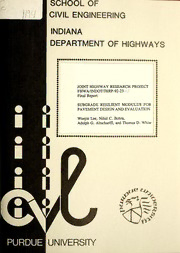Table Of ContentSCHOOL
L CIVIL ENGINEERING
lfi
INDIANA
DEPARTMENT OF HIGHWAYS
i
JOINT HIGHWAY RESEARCH PROJECT
FHWA/INDOT/JHRP-92-23
Final Report
SUBGRADE RESILIENT MODULUS FOR
:
PAVEMENT DESIGN AND EVALUATION
:
Woqjin Lee, Nihal C. Bohra,
Adolph G. Altschaeffl, and Thomas D. White
o
>v
\L7f>
PURDUE
UNIVERSITY
JOINT HIGHWAY RESEARCH PROJECT
-
FHWA/INDOT/JHRP-92-23
Final Report
SUBGRADE RESILIENT MODULUS FOR
PAVEMENT DESIGN AND EVALUATION
Woojin Lee, Nihal C. Bohra,
Adolph G. Altschaeffl, and Thomas D. White
Digitized by the Internet Archive
in 2011 with funding from
LYRASIS members and Sloan Foundation; Indiana Department of Transportation
http://www.archive.org/details/subgraderesilien9231leew
Final Report
SUBGRADE RESILIENT MODULUS FOR PAVEMENT DESIGN AND EVALUATION
To: DDrr.. VViinncceenntt DDrraaeevviicchh August 16, 1993
Joint Highway Research Project
Project: C-36-52N
From: Adolph G. Altschaeffl File: 6-20-14
Attached is the Final Report of the HPR study entided "Subgrade Resilient Modulus for
Pavement Design and Evaluation", prepared by Woojin Lee, N. Bohra, A. G. Altschaeffl, and
T. D. White. This reportouUines a set ofprocedures and testresults on subgrade soils in Indiana
to enable INDOT engineers to evaluate resilient modulus values for use in the design of
pavements.
A fully automated testing method has been developed to determine resilient modulus values
in the laboratory according to AASHTO T 274-82. Results are reported for both the laboratory
and the field compacted samples. The effect of environmental factors on resilient
modulus—freeze-thaw andpost-compactionmoisturechanges—hasbeenconsideredby simulating
these conditions in the laboratory. Freeze-thaw cycles were simulated in a freeze-thaw chamber.
An injection technique has been developed to achieve moderate increase in the post-compaction
water content.
Fabric studies were performed to explain the resilient response of the soil investigated.
Correlations were developed between the fabric parameters, clay content, and maximum
attainabledry unit weight. A nonparametric statistical study was carried out—based on a previous
study on a silty clay (CL, A-6 soil)—to identify laboratory compaction procedure capable of
replicating the field compacted fabric. Fabrics ofthe laboratory and field compacted soils—both
compacted and uncompacted (powdered) samples—were determined using mercury intrusion
porosimetry. Resilient response is correlated with the fabric parameters, pore water, and clay
content.
Respectfully submitted.
A. G. Altschaeffl
Research Engineer
cc: A. G. Altschaeffl W. L. Dolch C. W. Lovell G. Shoener
L. Bandy V. P. Draevich D. W. Lucas K. C. Sinha
M. Byers A. R. Fendrick B. Mason D. L. Tolbert
P. L. Bourdeau J. D. Fricker B. G. McCullouch L. Tucker
M. D. Bowman K. R. Hoover B. K. Partridge R. VanCleave
M. J. Cassidy R. B. Jacko F. P'Pool T. D. White
L. M. Chang L. S. Jones J. A. Ramirez L. E. Wood
E. Cox C. V. Kahl G. F. Rorbakken J. R. Wright
S. Diamond R. H. Lee C. F. Scholer
Final Report
SUBGRADE RESILIENT MODULUS FOR PAVEMENT
DESIGN AND EVALUATION
by
Woojin Lee, Nihal C. Bohra,
Adolph G. Altschaeffl, and Thomas D. White
Joint Highway Research Project
Project No.: C-36-52N
File No.: 6-20-14
Prepared for an Investigation
Conducted by the
Joint Highway Research Project
Engineering Experiment Station
Purdue University
in cooperation with the
Indiana Department of Transportation
and the
U. S. Department of Transportation
Federal Highway Administration
The contents of this report reflect the views of
the authors who are responsible for the facts and
the accuracy of the data presented herein. The
contents do not necessarily reflect the official
views or policies of the Federal Highway
Administration. This report does not constitute
a standard, specification, or regulation.
Purdue University
West Lafayette, Indiana 47907
August 16, 1993
TECHNICALREPORT STANDARDTITLEPAGE
1. ReportNo. 2. GovernmentAccessionNo. 3. Recipient'sCatalogNo.
FHWA/LNDOT/JHRP-92-23
4. TitleandSubtitle 5. ReportDate
August 16, 1993
Subgrade Resilient Modulus for Pavement Design and Evaluation 6. PerformingOrganizationCode
7. Auihor(s) 8. PerformingOrganizationReportNo.
Woojin Lee, N.C. Bohra,
FHWA/LNDOT/JHRP-92-23
A.G. Altschaeffl, and T.D. White
9. PerformingOrganizationNameand Address 10. Work UnitNo.
Joint Highway Research Project
Civil Engineering Building 11. ContractorGrant No.
Purdue University
West Lafayette, LN 47907
13.TypeofReportand PeriodCovered
12. SponsoringAgency Nameand Address
Indiana Department of Transportation Final Report
State Office Building
100 North Senate Avenue
14. SponsoringAgencyCode
Indianapolis, IN 46204
15. SupplementaryNotes
16. Abstract
The main goal of this study was to develop a set of testing procedure for resilient modulus and to
provide a set of resilient modulus data on typical Indiana soils. Soils tested were five cohesive soils
and one granular soil. Resilient modulus tests were performed in the laboratory on a fully automated
repeated-load triaxial equipment according to AASHTO T 274-82.
A set of correlations was developed between the resilient modulus and the unconfined
compression test results for normal and thawed subgrade conditions, based on the test results on the
specimen sampled from existing subgrades. Freeze-thaw and post compaction water content increase
effects were simulated in the laboratory by using a freeze-thaw chamber and an injection technique
respectively. The resilient modulus for frozen subgrade was also determined.
A nonparametric statistical technique was applied to identify a laboratory compaction method
capable of replicating the field compacted fabric. Fabric studies on the soils investigated were
performed using a mercury intrusion porosimeter. Deformability and resilient response were explained
by the fabric of compacted and uncompacted (powdered) soils.
A simplified design procedure was developed and it can be incorporated into 1986 AASHTO
Guide for Design of Pavement Structures. Developed correlation for normal subgrade condition will
help field engineers control the resilient properties of subgrade during construction. Also provided is
the procedure to determine the resilient modulus at specific levels of stresses using the design charts
developed.
17. KeyWords 18. DistributionStatement
No restrictions. This document is available
Resilient Modulus, pavement design, to the public through the
subgrade, soil fabric National Technical Information Service,
Springfield, Virginia 22161
19. Security Classif. (ofthis report) 20. SecurityClassif. (ofthispage) 21. No. ofPages 22. Price
Unclassified Unclassified 349
Form DOT F 1700.7 (8-69)

